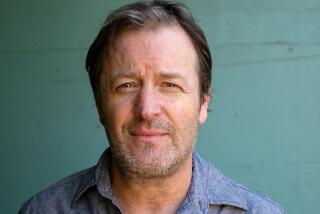Depressed? Sure. But ‘BoJack Horseman’ brought plenty of laughs in its run
- Share via
Few TV births are preserved in virtual amber, but “BoJack Horseman” creator Raphael Bob-Waksberg can point to the exact moment his show was born, which he shared on Twitter in March: A screen capture of an email he sent in 2010 to former high school buddy and comic artist Lisa Hanawalt: “Hey, do you have a picture of one of your horse guys, by himself? I came up with this idea for a show I’d like to pitch. Tell me what you think: BoJack the Depressed Talking Horse.”
A decade later, BoJack the depressed talking horse has hung up his hat, following six seasons, 77 episodes on Netflix, and two prime-time Emmy nominations. With him goes the legacy of one of the most unusual, insightful, adult animated TV series ever. And yes, that five-word concept Bob-Waksberg sent out in an email described the show to a T.
“It was a deep look at one man/horse’s journey through his depression, the people around him, his loved ones and family,” says executive producer and “Breaking Bad” actor Aaron Paul, who voiced multiple characters, including Todd Chavez. “We watched this horse/man trying to navigate his way through life, and live side-by-side with his depression.”

https://www.youtube.com/watch?v=i1eJMig5Ik4
Horses and animation aside, “BoJack” was never meant for the younger set — nor was it entirely about a depressed equine/man. (In BoJack’s universe, no one found it unusual that humans and animal-human hybrids existed side-by-side.)
“I wasn’t looking to do another cartoon show,” says Bob-Waksberg. “I thought about what I have not seen a ton of, and at the time Netflix was a relatively new platform and what they were doing with their shows were these highly serialized stories, which I hadn’t seen much in western adult animation.”
“Raphael always wanted to take the show into a deep place and examine things that are not always looked at in a comedic animation series,” says Alison Brie, who voiced BoJack’s best friend Diane. “The way he went into depression, alcoholism, dementia, regret, life in Hollywood was astounding and exciting.”
Getting “BoJack” from concept to air was far from an overnight endeavor. Tornante Television’s Steve Cohen and Noel Bright, who served as executive producers, saw a spark in Bob-Waksberg, a relatively untried East Coast transplant with no animation experience, and invited him in for meetings to discuss ideas.
Netflix’s ‘BoJack Horseman’ binge-worthy? Beyond snaring the likes of Will Arnett, Aaron Paul and Amy Sedaris, there isn’t much to graze on in this adult-oriented comedy available Friday.
“Toward the end of this meeting he pitched — well, blurted out, to call it a pitch is an overstatement,” says Cohen. “What was striking about it was, ‘What do you do when you don’t have happiness?’ That notion left us wanting more.”
Thus, the crew assembled: Bob-Waksberg shares a manager with Will Arnett, who signed on to executive produce and voice BoJack, and then Paul came on board. Bright says they attracted the attention of Netflix’s director of original series, Blair Fetter (who hadn’t necessarily been looking for animation, but was convinced after another charismatic pitch by Bob-Waksberg). Then Bob-Waksberg had to persuade Hanawalt to come on board as the production designer/producer.
Ensuring Hanawalt would sign on was a key call: Her drawings have a warm, hand-drawn quality (though the show’s animation was created on computers), watercolor shades, eye-popping colors and dozens of tiny details that gave texture and depth to her “BoJack” creations. (Prior to “BoJack,” she’d published one book of her work, “I Want You”; during the show’s run, she went on to create the recently renewed Netflix series “Tuca & Bertie.”)

Trailer for “Bojack Horseman” Season 6 on Netflix.
“I prefer animation that shows the human hand a little bit more,” she writes in an email. “We didn’t have the budget for hand-drawn animation, but little details helped to give the designs and backgrounds more character.”
Finally, Mike Hollingsworth joined the team as supervising director and “animation expert,” says Bob-Waksberg. “He brought a lot of the silliness to the show, at least in the beginning — he’s a real cartoon guy in ways Lisa and I were not. To me, a lot of the magic of the show is the three-headed monster of me, Lisa and Mike collaboratively.”
Still, the show was never just colorful artwork and scripts that tackled subjects like suicide, drug abuse and #MeToo moments, says Arnett. “If you’d made the show just overtly about BoJack being depressed and alcoholic, it might not be as funny — and people might not be inclined to tune in. It’s got a little bit of everything. It’s a funny show about a guy struggling with addiction, and that’s OK to laugh about.”
Five seasoned entertainment journalists predict the shows and performances the Television Academy will honor with Emmys; do you agree with their picks?
“All the story lines were so human and heartfelt and real,” says Amy Sedaris, who voiced characters including Princess Carolyn. “Everybody could relate to it in so many ways.”
In the end, Netflix called a halt to “BoJack” and Bob-Waksberg went on to do Amazon’s animated “Undone.” And the no-longer-rookie animation show creator says he’s happy as long as he can keep doing the unexpected.
“I’m not looking for ‘Jurassic Park’ or ‘Star Wars,’” he says with a chuckle. “I want to burn up any cachet I have by doing small, weird and niche stuff. Hopefully, I have room to do that before no one wants to work with me again.”
More to Read
From the Oscars to the Emmys.
Get the Envelope newsletter for exclusive awards season coverage, behind-the-scenes stories from the Envelope podcast and columnist Glenn Whipp’s must-read analysis.
You may occasionally receive promotional content from the Los Angeles Times.










